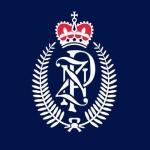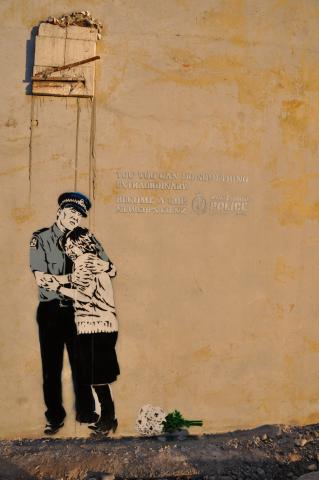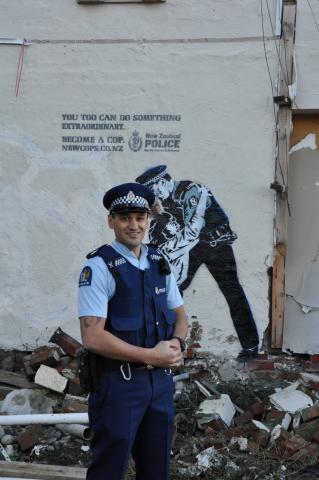Extraordinary police stories from quake re-surface as street art in Christchurch
When Constable Nao Yoshimizu and Constable Spence Kingi started their shifts on 22nd February, neither knew what would be in store in the days ahead.
Each took on significant roles in the earthquake rescue and recovery effort. They displayed bravery, compassion and quick thinking - qualities which are in high demand by police recruitment.
Their stories are now being re-told through street art on Christchurch streets. The artwork was created by Otis Frizzell who is working with police to acknowledge the extraordinary work undertaken by these officers and other emergency responders following the February 22 earthquake.
Acting Canterbury District Commander, Superintendent Andy McGregor, says the new recruitment initiative was inspired not only by emergency responders activities during the quake, but also by the huge number of young people who responded by donating their time and resources to clean up the city.
"It really reinforced that many young people are passionate about helping their community in times of need. Police are keen to tap into that passion and demonstrate that Policing offers a career choice which is both exciting and rewarding.
"We understand that New Zealand's brightest young people are in high demand. As such, NZ Police needs to pitch its career in a different way," says Andy.
On 22 February Constable Kingi helped to rescue three people.
Spence's first act was to rescue a woman from an elevator shaft in a crumbling building. He then rescued a concussed man from the drop zone off falling scaffolding and performed first aid. Finally, Constable Kingi worked with a member of the public to free a man trapped beneath the rubble of a CBD bar.
Otis Frizzell has captured Spence's story on the wall of 399 Montreal Street. His likeness is seen pulling a victim out of the rubble which lies beneath the artwork.
Constable Nao Yoshimizu's story is one of the lesser known stories from the earthquake.
Yoshi acted as a liaison officer for the families of the 28 Japanese victims following the February earthquake. When relatives of the victims arrived from Japan, they struggled to comprehend what was happening.
Yoshi's compassion for the victims' families was demonstrated when escorting family members to sites of significance around Christchurch.
Yoshi understood that it is common in Japanese culture to "feel and care for the recently deceased as though he/she were still alive."
He knew that a memorial and the laying of white flowers at the location of death was crucial to allow the victims' spirits to live onward. However when the bus arrived at the CTV building site, Yoshi was informed that passengers were unable to leave the bus because safety of concerns.
Yoshi offered to take the families’ flowers, to lay them at the CTV site on their behalf. At this moment, Yoshi was sharing the grief of his own people for those lives which were tragically lost.
As a police officer, he enabled important cultural traditions to be respected while ensuring the safety of the victim's families.
Yoshi's artwork can be found on 817 Colombo street. Out of respect for the privacy of those who died, the civilians featured in the Christchurch artwork are actors. Given the sensitive nature surrounding both stories, local Japanese communities have been consulted prior to installing the artwork.
Both artwork sites were blessed by the Iwi before installing the street art.
Superintendent McGregor says he hopes re-telling extraordinary police stories through street art will encourage young people look at policing in a different light.
"We are actively looking to recruit young people with an understanding of different cultures and languages. The February earthquake showed how important this is. Families from 20 countries were affected by the February earthquake. NZ Police Maori Pacific and Ethnic Services were able to assign liaison officers with an understanding of the language and cultural requirements of every nationality involved.
"We hope that through telling Yoshi's and Spence's stories we can inspire others to take on the extraordinary challenges offered by a career in NZ Police."
Similar art installations have already been undertaken in Auckland and Wellington in an effort to tell extraordinary police stories in local communities.
Together with the Christchurch stories, the artwork will form the basis of a nationwide outdoor, reality TV and online recruitment drive. All necessary approvals have been sought and given to make the art installations happen.
Constable Spence Kingi's story:
When Spence started his shift on at 7am on February 22nd, he had no idea what would await him at 1pm that afternoon.
When the earthquake hit, Constable Kingi put it all on the line to rescue those who needed his help.
“I was marching down the road when a guy came out and pointed at this ruined building. He told me there were a number of his employees inside and they couldn’t get out.”
Spence went straight through the doors, with no hard hat or safety gear.
“When I reached the fourth floor I yelled down the lift shaft. I could faintly hear a female’s voice. She said she was alright, but was trapped and frightened.” Bricks and broken glass were falling inside the stairwell as he descended.
“By the time I got to the 2nd floor another officer was coming up from the bottom of the building. When the door was opened, the lift was halfway between the second and third floor. The woman was pretty happy to see us.”
Spence reflects on his time at Police College: “I swore an oath, which among other things was about preserving life. And that’s basically what I was there to do, what I wanted to do, to make sure that building was clear.”
Following the first rescue, Spence ran down Hereford Street where he helped a man who had been struck by falling scaffolding.
“The scaffolding had fallen onto his head from four or five stories above. I helped drag him clear of the drop zone to the middle of the road. I administered first aid - he was unconcious but breathing.”
The ambulances were busy so other bystanders flagged down a van to take the man to hospital. A relative of the man also arrived at the scene.
“Although I was concerned for the man’s health, I knew there was nothing more I could do for him. I left him with his relative and was very happy to hear he was on the plane to the UK two days later.”
Spence then moved on to Manchester street where a bar had collapsed on the workers inside. Although the ground was continuing to shake, Spence stuck to his Police College oath as he worked alongside a brave member of the public clearing massive slabs of concrete with their bare hands to free those underneath.
As a young Maori officer, Constable Kingi is an ambassador for the type of person NZ Police wants to recruit.
Constable Nao Yoshimizu's story:
Constable Nao Yoshimizu ("Yoshi") was the liaison officer for the families of the 28 Japanese victims following the February earthquake.
Many Japanese families bought tickets to New Zealand when they heard about the quake and arrived within 48 hours of the initial shock.
Families struggled to comprehend what had happened, the whereabouts of their loved ones, and what was being done as part of the rescue and recovery operation.
Yoshi's understanding of the language and the culture enabled him to gain the trust of the families. As a police officer, he became a pillar of support.
It is common in Japanese culture to "feel and care for the recently deceased as though he/she were still alive."
The laying of white flowers and a memorial at the site of the death are crucial to enable the family members' spirit to live on forever.
Yoshi undertsood this and escorted a bus of relatives and family members to sites of significance around Christchurch, including the CTV building.
During the bus tour, Yoshi had to comfort the families who were unable to venture outside the bus to lay flowers because of the continued danger at the CTV site.
Recognising that placing flowers was crucial to the Japanese grieving process, Yoshi took the families’ flowers and laid them at the CTV site on their behalf.
Yoshi was also central in helping family members to understand what was happening during the rescue and recovery operation.
He took initiative and asked the Japanese USAR team to speak at regular family meetings. Throughout the event, police received intense interest from the Japanese media.
Yoshi was able to provide translations and key messages to the international media at the police media briefings. He also liaised directly with the Japanese Embassy & foreign officials on behalf of NZ Police.
Finally, Yoshi helped the families to understand the disaster victim identification (DVI) process. He gathered essential information from the international and local japanese families to assist police with identifying the victims from the quake.
We hope that by telling Yoshi's story, we can help encourage people from a wide variety of backgrounds to take up the challenge and opportunity offered by a career in NZ Police.
Put simply, we need more people like him.


